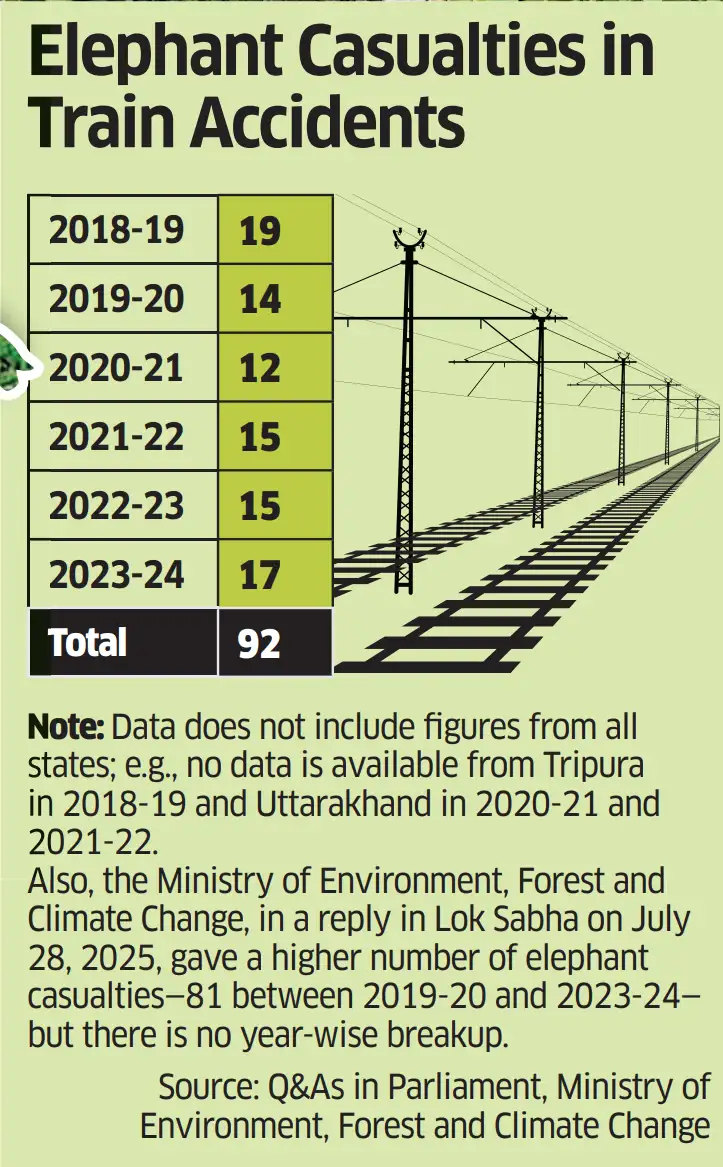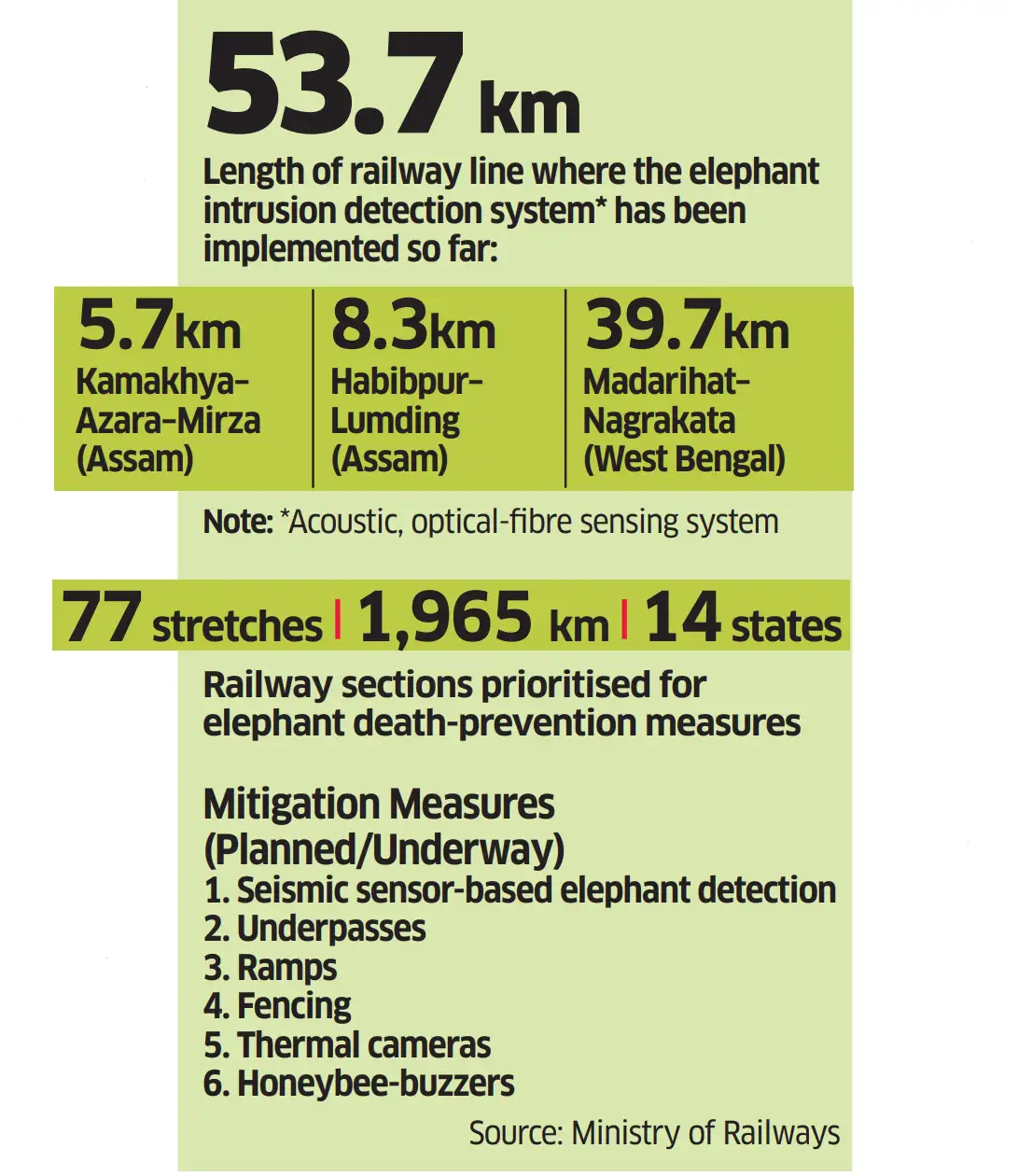Over the subsequent 4 months, they fired off letter after letter—to forest departments, zoos in Jamshedpur and Ranchi and even a non-public company in distant Bhopal—nearly pleading them to mortgage elephants. Aid lastly got here from a temple belief linked to the Reliance Group's Vantara, which dispatched two elephants from Deoria in Uttar Pradesh. The animals have been ferried all the way in which to Chakradharpur in a specifically constructed animal ambulance.
“We wanted elephants for the trial, because the signature of footsteps from one other animal could be utterly completely different,” says Tarun Huria, divisional railway supervisor, Chakradharpur. “We performed a number of trials—of elephants stepping onto the observe, shifting away from it, strolling parallel and even simulated herd actions. Lastly, we zeroed in on the correct provider for the Elephant Intrusion Detection System (EIDS), which may decide up elephant actions not less than 20 metres from the opticalfibre cable alongside the tracks.”
In designated elephant corridors, the system will observe and show steady elephant actions from so far as 150-200 metres from the centre of the observe. Huria provides that the identical know-how may later be tailored to trace different animals, say, camels straying too near railway strains in Rajasthan.

MAMMOTH TASK AHEAD
Yearly, greater than a dozen elephants get killed on India's railway tracks, and plenty of extra are left injured by dashing trains. The federal government is now racing to guard the animal with a mixture of new applied sciences reminiscent of EIDS and thermal cameras alongside standard measures like wildlife underpasses, bridges for elephants, ramps and fencing. And in a unusual twist, honeybee-buzzer gadgets have been put in at some degree crossings to repel elephants and steer them away from the tracks.
India is house to 29,964 elephants, based on the final nationwide census performed in 2017. However their habitats are shrinking quick. Highways, expressways and the relentless doubling and tripling of railway tracks are slicing by forest corridors, pushing elephants into usually deadly collisions with trains. The Indian Railways' drive to lift practice speeds, together with the arrival of semi-highspeed companies just like the Vande Bharat, has solely heightened the danger.
Authorities data present not less than 92 elephants have been killed in practice collisions between 2018-19 and 2023-24. The actual toll is sort of actually greater as some deaths go unreported. In a written reply to the Lok Sabha on July 28, 2025, the Ministry of Atmosphere, Forest and Local weather Change (MoEF&CC) acknowledged 81 casualties from 2019-20 to 2023-24, although it didn't share a year-wise breakup. Additionally, the variety of injured elephants hit by trains isn't available.
A 2024 report, “Handbook to Mitigate the Impacts of Roads and Railways on Asian Elephants”, printed by the Asian Elephant Transport Working Group, reveals the magnitude of the disaster: 355 elephants died in practice collisions in India between 1987 and April 2023, practically two-thirds of them in simply two states, Assam and West Bengal. “Trainelephant collisions have been discovered to happen extra usually at evening and concerned extra male elephants when accounted for by way of ratio within the inhabitants, as males could cross the tracks extra usually to embark on crop raiding behaviour throughout crop harvest season,” the report says.
A March 2025 report by MoEF&CC and the Wildlife Institute of India has really helpful mitigation measures for 77 railway stretches overlaying 1,965 km throughout 14 states. The plan requires 705 new constructions: 503 ramps and degree crossings, 72 bridge extensions or modifications, 39 fencing, barricades or trenches, 4 exit ramps, 65 underpasses and 22 overpasses. The planning for a few of these has already begun.

EXPRESS THROUGH ELEPHANT CORRIDOR
Final week, this author boarded the Ispat Categorical, a superfast practice that cuts by among the most susceptible elephant corridors on the Jharkhand-Odisha border, to witness first-hand the dilemma confronted by loco pilots navigating these habitats.
“We take further warning in elephant corridors,” says RN Gudu, 55, the practice's loco pilot. “On sure stretches — for instance, between Jaraikela and Manoharpur on Jharkhand-Odisha border—we're instructed to sluggish trains to 40 kmph from 6 pm to six am. Even the Vande Bharat driver should adjust to this rule.”
One other loco pilot, Abhimanyu Singh, who drives the South Bihar Categorical on the identical route, says: “In daylight you'll be able to scan the environment, however at evening you see solely about 150-200 metres of observe forward.”
WARNING SYSTEM
In keeping with the Tamil Nadu forest division data, practically 9,000 elephant crossings have been logged within the Madukkarai forest vary in Coimbatore, close to the Kerala border, between 2021 and 2023. With round 300 trains passing by these elephant corridors each day, the danger is fixed. Alarm bells rang in 2021, when three feminine elephants have been killed by trains within the Madukkarai-Coimbatore stretch.
“The state forest division launched an AI-powered surveillance challenge in February 2024, putting in thermal and common cameras on 12 towers alongside a essential 7 km stretch in Madukkarai,” says Supriya Sahu, further chief secretary, Atmosphere, Local weather Change & Forests Division, Tamil Nadu. “Final yr alone, there have been 342 situations when elephants have been noticed on the tracks and drivers have been alerted in time, considerably decreasing collisions.”
She provides that the division now plans to duplicate and prolong this early-warning system to different essential elephant and wildlife corridors. Future upgrades could embrace integration with drone surveillance and wider use of superior instruments reminiscent of geophones, fibre-based sensing and radar techniques.
In the meantime, the North East Frontier Railway has rolled out an AI-enabled intrusion detection system, additionally referred to as DAS (Distributed Acoustic Sensors), throughout 53.7 km of observe—39.7 km in West Bengal and 14 km in Assam. The system detects elephant motion close to the tracks and immediately alerts loco pilots, station masters and management rooms, enabling well timed preventive motion.
Railway paperwork present that work is now underway to develop the know-how throughout 147 km of elephant corridors—70 km in Assam and 77 km in West Bengal. In all, this sensor-based system has been sanctioned for 1,158 km of railway strains, at an estimated value of `208 crore, based on info tabled within the Rajya Sabha final month.
ARE HATHI PASSES WORKING?
Whereas the effectiveness of many new-age applied sciences continues to be untested, that is additionally the time for Indian Railways to take inventory of its current measures—bridges and underpasses constructed over the previous decade completely for elephants and different wildlife—and assess how properly they're working. In lots of locations, current mitigation measures want pressing upgrades reminiscent of higher barricading and set up of sunshine and sound obstacles.
In 2015, two hathi passes—grass-covered wildlife bridges for elephants—have been constructed within the forests of Hazaribagh in Jharkhand, as a brand new railway line from Koderma to Hazaribagh minimize by hillocks alongside conventional elephant corridors. A decade on, the elephants have all however deserted this habitat.
Final week, a drive on an extended, winding rural street and a kilometre's stroll by the forest-fringed village of Barikola Jhonjh led us to a hathi cross. Within the fading mild, an previous lady was herding house two dozen cows, goats and sheep—utilizing the hathi cross. The animals appeared at house; the bridge was serving them properly. However the giants it was constructed for have been nowhere in sight.
“From the time this bridge was constructed, elephants have stopped coming right here,” says villager Binod Munda with a wry smile.
In a 55-km stretch in Odisha beneath the Chakradharpur railway division, 11 new hathi passes have been lately sanctioned, with the federal government setting apart `234 crore for the challenge. Related bridges are on the drafting board in Jharkhand and different states.
However has something been learnt from Hazaribagh's deserted overpass in Munda's village? Officers insist the brand new era of bridges can be completely different. “They're being designed to actively draw elephants in,” says a Chakradharpur official, who's drafting the price range for them. “The plans even embrace planting jackfruit and banana bushes to entice the herds.” Will the elephants chew?










